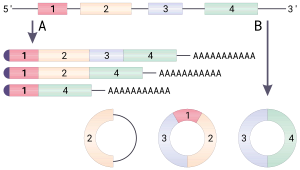
2. Barrett, S. P. & Salzman, J (2016). Circular RNAs: analysis, expression and potential functions. Development 143, 1838-1847. [doi:10.1242/dev.128074]
3. Li, X., Yang, L. & Chen, L. L (2018). The Biogenesis, Functions, and Challenges of Circular RNAs. Mol Cell 71, 428-442. [doi:10.1016/j.molcel.2018.06.034]
4. Jeck, W. R. et al (2013). Circular RNAs are abundant, conserved, and associated with ALU repeats. RNA 19, 141-157. [doi:10.1261/rna.035667.112]
5. Salzman, J., Gawad, C., Wang, P. L., Lacayo, N. & Brown, P. O (2012). Circular RNAs are the predominant transcript isoform from hundreds of human genes in diverse cell types. PLoS One 7, e30733. [doi:10.1371/journal.pone.0030733]
7. Memczak, S. et al (2013). Circular RNAs are a large class of animal RNAs with regulatory potency. Nature 495, 333-338. [doi:10.1038/nature11928]
10. Zhang, Y. et al (2013). Circular intronic long noncoding RNAs. Mol Cell 51, 792-806. [doi:10.1016/j.molcel.2013.08.017]
13. Yang, Y. et al (2017). Extensive translation of circular RNAs driven by N(6)-methyladenosine. Cell Res 27, 626-641. [doi:10.1038/cr.2017.31]
14. Legnini, I. et al (2017). Circ-ZNF609 Is a Circular RNA that Can Be Translated and Functions in Myogenesis. Mol Cell 66, 22-37 e29. [doi:10.1016/j.molcel.2017.02.017]
15. Pamudurti, N. R. et al (2017). Translation of CircRNAs. Mol Cell 66, 9-21 e27. [doi:10.1016/j.molcel.2017.02.021]
Citation
- [1]Huang W#, Ling Y#, Zhang S, Xia Q, Cao R, Fan X, Fang Z, Wang Z*, Zhang G*. TransCirc: an interactive database for translatable circular RNAs based on multi-omics evidence. Nucleic Acids Res 2021, 49:D236-D242. [Read full article]
